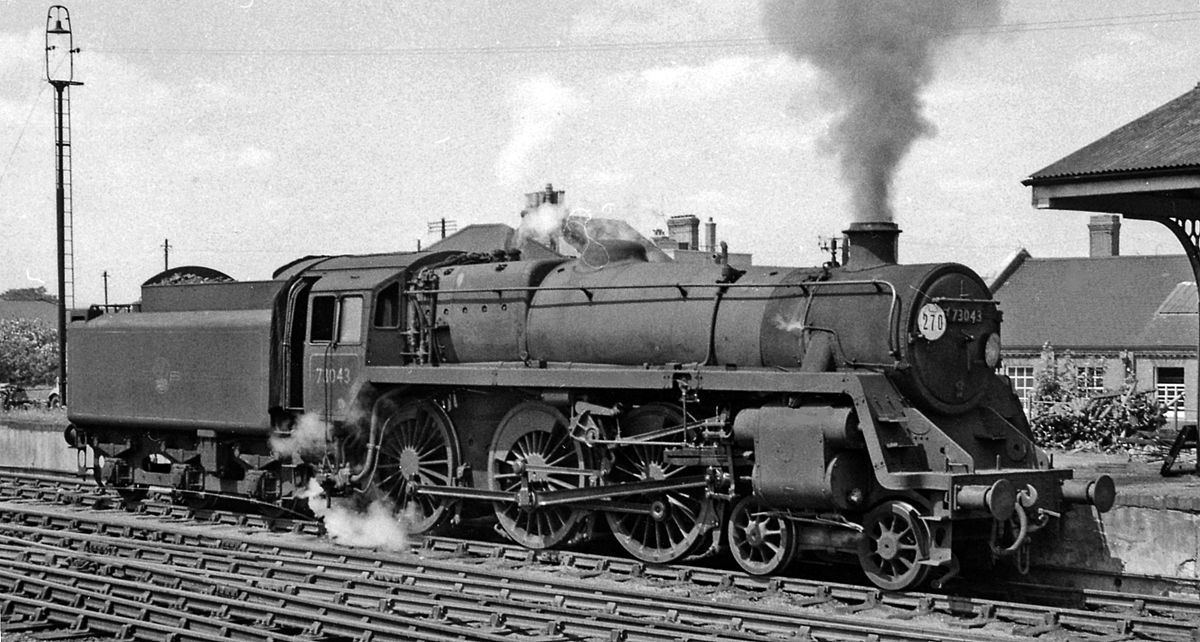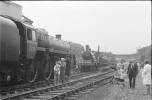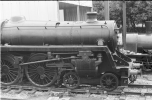DarloRich
Veteran Member
Does that "go"?the class 15,
I second the class 17. An interesting beastie!
class 28 surely? Is that not at ELR with the aforementioned class 15?Anyone know where the Metrovick Co-Bo class 29 is at the moment?
Does that "go"?the class 15,
class 28 surely? Is that not at ELR with the aforementioned class 15?Anyone know where the Metrovick Co-Bo class 29 is at the moment?
Class 28 if you don't mind! I believe it's undergoing restoration at Bury.Anyone know where the Metrovick Co-Bo class 29 is at the moment?
There was an attempt to build 77021, the next in class of the Standard Class 3 2-6-0, but it was a tiny team that never really made waves or funding.Of which there are projects in progress to construct a Clan Pacific and a Class 3 2-6-2T, and create a Class 2 2-6-2T (from a 2-6-0): leaving only the Class 3 2-6-0 unrepresented.
The Gresley W1 rebuild never made it, despite some historic importance!
Oops yes sorry about the typo. Aha I will try to get to see it. Thanks.Class 28 if you don't mind! I believe it's undergoing restoration at Bury.
I was going to say classes 15,17 and 28. Saw the 28 dumped at Swindon works in the 80s, the owners had to pay 'rent' to BR and it wasn't cheap too.I’d say the class 15, class 17, class 28 and prototype HST power car are all very interesting single surviving members of their types.
Well, it's bodyshell.18000 is a very unlikely survivor.
But it survived.
Which one? It had one tender before rebuilding and a couple after, being withdrawn attached to tender No 5639 in June 1959. Yeadon’s Register states tender 5639 remained spare at Doncaster until January 1962 and was then sold for scrap.It's tender did though.
Which one? It had one tender before rebuilding and a couple after, being withdrawn attached to tender No 5639 in June 1959. Yeadon’s Register states tender 5639 remained spare at Doncaster until January 1962 and was then sold for scrap.
Yes indeed, 5484 does exist! The elusive A4 60004 had the tender from June 1948 until withdrawal in July 1966. Tender 5484 was then transferred to withdrawn 60009 prior to its sale into preservation.Original 5484 which it had until 1948.
They owe their survival to their time in industry. For a preserved line, they are pretty much ideal: can be used for shunting (much better visibility from the cab than an 08), p-way work and also working passenger trains. The 40mph top speed doesn’t matter on such railways and from an enthusiast’s point of view they make some nice Paxman noises…On the opposite theme, can anyone offer an explanation for why there are so many Class 14’s in preservation? Nice loco’s for sure, but they do seem disproportionately numerous.
I suspect that it's because when they withdrawn at between 5 and 10 years old - due to the rapid disappearance of the traffic for which they were designed - they were still pretty new and in good condition. At about the same time the National Coal Board were looking to replace much of their large fleet of steam shunters at numerous collieries around the country and the 'Teddy Bears' were a natural 'shoe-in' for a seemless transfer from one nationalised industry to another. I believe that the whole class of 56 locos was sold into industrial service - the majority to the NCB - and most of their fleet were concentrated in the Ashington area of Northumberland for ease of maintenance and exchange of parts. As a result, a large number of these locos were still in service until the end of the coal industry in the late 1980s/early 1990s - by which time the railway preservation movement was well-established - and these suddenly available economical and lightweight, but powerful trip/shunting locos were ripe for the picking.On the opposite theme, can anyone offer an explanation for why there are so many Class 14’s in preservation? Nice loco’s for sure, but they do seem disproportionately numerous.
Thanks for that wonderful explanationI suspect that it's because when they withdrawn at between 5 and 10 years old - due to the rapid disappearance of the traffic for which they were designed - they were still pretty new and in good condition. At about the same time the National Coal Board were looking to replace much of their large fleet of steam shunters at numerous collieries around the country and the 'Teddy Bears' were a natural 'shoe-in' for a seemless transfer from one nationalised industry to another. I believe that the whole class of 56 locos was sold into industrial service - the majority to the NCB - and most of their fleet were concentrated in the Ashington area of Northumberland for ease of maintenance and exchange of parts. As a result, a large number of these locos were still in service until the end of the coal industry in the late 1980s/early 1990s - by which time the railway preservation movement was well-established - and these suddenly available economical and lightweight, but powerful trip/shunting locos were ripe for the picking.

On the opposite theme, can anyone offer an explanation for why there are so many Class 14’s in preservation? Nice loco’s for sure, but they do seem disproportionately numerous.
Thanks for that great explanation too!Despite being reliable they were non-standard and the work they were designed for was all but dead anyway, so they were sold into industries that just so happened to be on the decline or disposing of their internal rail networks about the same time as rail preservation had a boom in the late 70s and early 80s, this time not purely focused on steam, but on diesel too. They were ideal. relatively lightly used but typically well maintained, their fairly low speed's no disadvantage in preservation, but more useful than an 08's.
Having engines that saw pretty widespread naval use probably helped too and people knew spares would probably still be being produced at the time, and would at least be available.
The APT did run in revenue earning service for a time and quite successfully. They made some appearances on services normally loco hauled for about 18mths to 2 years in the mid 80s. My father was most surprised to discover that his normally 86/2 or 87 headed service from Euston was actually an APT-P on one occasion. They were never timetabled or adverrtised though.Counting prototype trains we can count the APT, but it never ran in revenue service unlike the 89.
Another one off prototype that ran in revenue service and made it into preservation would be the double decker 4DD.
Not all the 14s went into industrial service and not all were nationalised industries. It was also not a majority to the NCB.I suspect that it's because when they withdrawn at between 5 and 10 years old - due to the rapid disappearance of the traffic for which they were designed - they were still pretty new and in good condition. At about the same time the National Coal Board were looking to replace much of their large fleet of steam shunters at numerous collieries around the country and the 'Teddy Bears' were a natural 'shoe-in' for a seemless transfer from one nationalised industry to another. I believe that the whole class of 56 locos was sold into industrial service - the majority to the NCB - and most of their fleet were concentrated in the Ashington area of Northumberland for ease of maintenance and exchange of parts. As a result, a large number of these locos were still in service until the end of the coal industry in the late 1980s/early 1990s - by which time the railway preservation movement was well-established - and these suddenly available economical and lightweight, but powerful trip/shunting locos were ripe for the picking.
BR Standard 5mt No: 73129 is said to be one of 2 locos with Caprotti valve gear left in the UK, with the other being Duke of Gloucester.

BR Standard Class 5 - Wikipedia
en.wikipedia.org

73129
73129 was built at Derby in August 1956 as one of a batch of 30 locomotives fitted with Caprotti valve gear. It is the only surviving member of the class with Caprotti valve gear. The only other pr…preservedbritishsteamlocomotives.com


You'd think someone would take a couple of 08s and make 13004.As has been pointed out upthread, no master and slave shunter aka Class 13 made it. I thought John Wade may have bout one for Heritage Shunters Trust at Rowsley.
You'd think someone would take a couple of 08s and make 13004.
Then it would have to be 13101.Give it "09" gearing and it'd be a very handy thing at many preserved lines
They may well have been too valuable to BR as spares donors for the 08 and 09 fleets.As has been pointed out upthread, no master and slave shunter aka Class 13 made it. I thought John Wade may have bought one for Heritage Shunters Trust at Rowsley.
Didn't think that existed when they were withdrawn? Think last one was scrapped around 1986?As has been pointed out upthread, no master and slave shunter aka Class 13 made it. I thought John Wade may have bought one for Heritage Shunters Trust at Rowsley.
Yes you are probably right.Didn't think that existed when they were withdrawn? Think last one was scrapped around 1986?
0802 from Glasgow southbound, can't remember the other times.The APT did run in revenue earning service for a time and quite successfully. They made some appearances on services normally loco hauled for about 18mths to 2 years in the mid 80s. My father was most surprised to discover that his normally 86/2 or 87 headed service from Euston was actually an APT-P on one occasion. They were never timetabled or adverrtised though.
+1 for the HSDT (as was originally known). It set the scene for fast and reliable inter-city transit. BR's most successful product.I’d say the class 15, class 17, class 28 and prototype HST power car are all very interesting single surviving members of their types.
The 15 is interesting, as they would almost certainly have gone extinct had it not been for D8233 and 3 others (sorry don’t have the numbers to hand) being saved for ETH (electric train heating) purposes. I forget how the 17 got saved but the 28 was also departmental of some sort. The 15’s close cousins the Class 16 are extinct, which is hardly surprising given how poor the class was.I’d say the class 15, class 17, class 28 and prototype HST power car are all very interesting single surviving members of their types.
